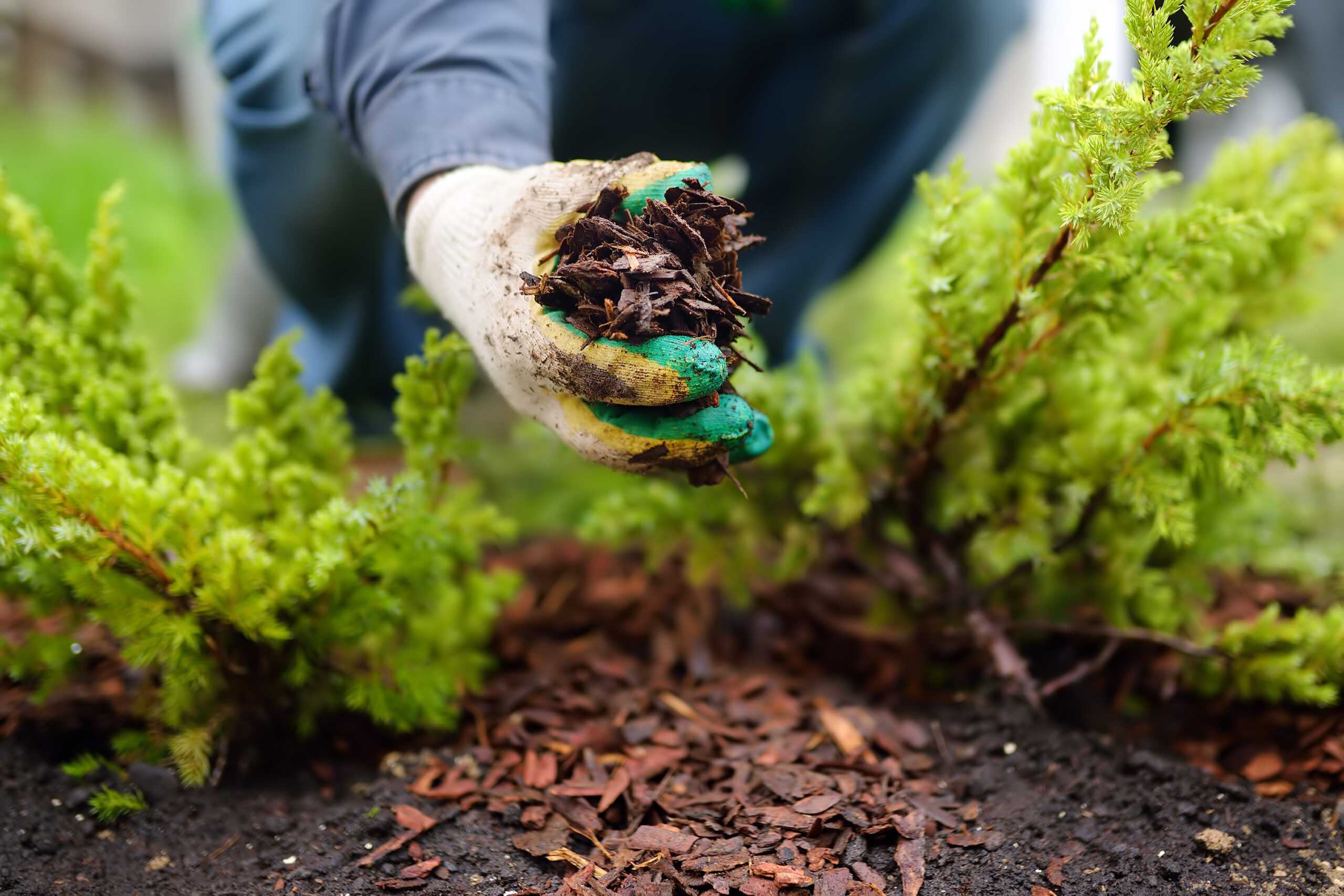Mulch can be defined as any organic or inorganic material used to protect the soil from moisture loss and/or improve the soil condition when applied to the soil surface.
Use mulch to help keep weeds out and moisture in. Mulches come in many forms, pine back, straw, mini nuggets, rock, shredded back, coco shells.
Mulching, great for keeping your garden free of weeds, is effective and simple. This will also help to keep the plants healthy, and will keep your garden plants looking beautiful.
Mulch your garden at the beginning of the growing season each year. This protective layer of mulch insulates the soil from the hot summer sun, protects it from drying winds, and all but eliminates weeds.
Mulches cover the soil, keeping it cool and minimizing the evaporation of soil moisture. Mulching can reduce the water required to one third of the amount throughout the growing season. The soil stays evenly moist under the mulch. And as the organic mulches decay, they improve the soil.
Mulches also reduce weed growth , help the soil capture precipitation, reduce runoff and erosion. Mulches help maintain a more constant soil temperature, buffering the extremes, thus favoring healthy populations of earthworms and other beneficial life in the soil.
There are a range of mulches: Inorganic, and organic. Organic mulches include wood chips, straw, peat moss, sawdust, dry manure, leaves, pine needles, grass clippings and bark chips. Inorganic mulches include rock, gravel, lava.
After the mulch is applied, you don’t have to hoe between the rows. For mulching to be effective it should be approximately 3 inches thick. The use of mulches is a key to successful Xeriscape.
Many materials are available including; rocks, gravel, wood chips, pine needles and compost. In windy areas like the Antelope Valley, use mulch under a rock layer or cover with landscape netting to reduce erosion. Mulches should be placed several inches away from tree trunks and should extend outward.

When to Apply Mulches
If the mulch is used to control weeds or for aesthetics, it should be spread before the weeds begin to come up. Otherwise the weeds will have a toehold on the area. If the mulches are primarily to protect new transplants from freezes in the fall, mulches should be applied soon after transplanting. If the mulch is to be used to reduce frost-heave and delay spring growth with such plants a s crocus and other bulbs, the mulch should be applied after the ground has frozen.
Homeowners generally have two choices when applying mulches. One can apply a 3″-4″ depth of mulch on top of the soil’s surface or apply a layer of mulch over a geotextile fabric. A geotextile fabric is a woven fabric that acts as a weed barrier. BLACK PLASTIC SHOULD NOT BE USED AS A WEED BARRIER. The trouble with black plastic is that it does not allow the water and air to enter leave the soil. This then does not allow the roots of trees and shrubs to get water they need thus may stress the tree or shrub.
Inorganic Mulches
Inorganic mulches, rock and gravels can add color and textural interest to the ground. In the dry zones of the garden, rock can give a clean, tidy appearance and will not blow away. For rock gardens and perennial gardens using xeric plants, crushed gravel is the mulch of choice since it encourages many perennials to self seed.
Santolina, Flax, Penstemon, Lavender, Cariopteris, Agastache, Yuccas, and Ornamental Grasses, along with many native species, thrive in a rock mulch. Rock mulches are suitable for very windy situations where lighter materials will blow away. Also, in areas bordering on wild land where grass fires can occur, rock mulch can be used adjacent to outbuildings etc. as a barrier to fire. The disadvantage of rock is that it produces reflected heat and glare, an important consideration around patios, building entries & windows exposed to the sun.
Organic Mulches
Organic mulches come in a variety of forms. They have the advantage not reflecting heat and glare and of gradually adding organic matter to the soil. For flower beds where there is always planting activity the best mulch is a coarse compost that can be dug into the soil when planting new plants. For more permanent plantings such as trees shrubs and groundcover, suitable mulches are: pine needles, bark chips or screened hog fuel.
Homeowners should be aware of the possibility of nitrogen deficiency with the decomposing of organic mulch. As organic mulches decompose, some of the soils’s nitrogen is used by the breakdown organisms. Consequently, nitrogen deficiency may occur. A sign of nitrogen deficiency is a yellowing of plant material, primarily of the lower leaves. When this occurs, nitrogen fertilizers should be added to the surrounding plant materials.
| Cookie | Duration | Description |
|---|---|---|
| cookielawinfo-checkbox-analytics | 11 months | This cookie is set by GDPR Cookie Consent plugin. The cookie is used to store the user consent for the cookies in the category "Analytics". |
| cookielawinfo-checkbox-functional | 11 months | The cookie is set by GDPR cookie consent to record the user consent for the cookies in the category "Functional". |
| cookielawinfo-checkbox-necessary | 11 months | This cookie is set by GDPR Cookie Consent plugin. The cookies is used to store the user consent for the cookies in the category "Necessary". |
| cookielawinfo-checkbox-others | 11 months | This cookie is set by GDPR Cookie Consent plugin. The cookie is used to store the user consent for the cookies in the category "Other. |
| cookielawinfo-checkbox-performance | 11 months | This cookie is set by GDPR Cookie Consent plugin. The cookie is used to store the user consent for the cookies in the category "Performance". |
| viewed_cookie_policy | 11 months | The cookie is set by the GDPR Cookie Consent plugin and is used to store whether or not user has consented to the use of cookies. It does not store any personal data. |
